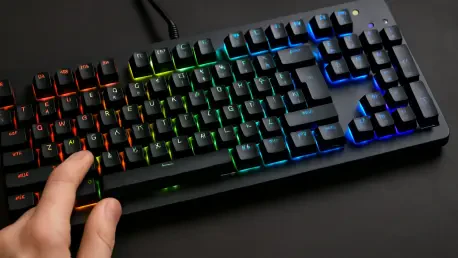Imagine diving into an intense gaming session, fingers poised over a mechanical keyboard that promises durability and precision, only to find mixed results in performance and comfort. In the ever-evolving world of gaming peripherals, selecting the right keyboard can make or break the experience. This roundup gathers diverse opinions, reviews, and tips from multiple sources across the gaming community to dissect a notable contender in the wired mechanical keyboard market. The purpose here is to provide a balanced perspective on this device, highlighting its strengths, shortcomings, and overall value to help gamers make informed decisions.
Diverse Perspectives on Build Quality and Design
Kicking off the discussion, the construction of this keyboard often garners praise for its robust metal chassis, which many reviewers note as a standout feature suggesting long-term durability. The use of high-quality ABS keycaps adds a premium touch, often surprising users who expect less from this material compared to pricier alternatives. A compact full-size layout further appeals to those seeking a less bulky desk presence without sacrificing functionality.
However, not all feedback on the design is glowing. Some critiques point to the metal frame’s dated aesthetic, which can appear cheap despite its sturdiness. This split in opinion raises questions about whether visual appeal should weigh as heavily as structural integrity in a premium gaming peripheral. The vibrant RGB lighting, though, frequently receives positive nods for adding a modern flair to an otherwise retro look.
A recurring theme among enthusiasts is the balance between form and function. While the solid build instills confidence in the product’s longevity, the aesthetic drawbacks may deter users who prioritize a sleek, contemporary style. This dichotomy suggests that personal taste plays a significant role in assessing the design’s overall impact.
Performance in Gaming and Typing: A Mixed Bag
Turning to performance, opinions vary widely on how this keyboard handles the demands of gaming and typing. Many users appreciate the MX2A Silent Red switches for their tactile feedback, particularly beneficial for touch typists who value precision. The short key travel is often cited as an advantage in enhancing typing accuracy during long sessions.
Conversely, feedback on gaming performance reveals notable concerns. Several sources highlight the heavier-than-expected actuation force of the switches, which can lead to a harsh feel during fast-paced gameplay. This characteristic may hinder competitive gamers who rely on rapid, light key presses, creating a divide in suitability depending on gaming style.
An additional layer of insight comes from comparisons in real-world usage. While the indented keycaps aid in maintaining finger placement, the lack of dampening in the switches often results in discomfort during extended play. This split in user experience underscores the importance of aligning the keyboard’s features with specific user needs, whether for casual play or professional typing tasks.
Ergonomic Considerations: Comfort on Trial
Delving into ergonomics, a significant point of contention emerges around the keyboard’s design for long-term use. The unconventional screw-in pins for angle adjustment are frequently criticized for offering limited tilt, resulting in a flat typing angle that strains wrists over time. Many users express frustration over this outdated approach compared to more adjustable alternatives.
Further compounding discomfort is the thick chassis paired with an absence of wrist support. Feedback from various reviews suggests that this design oversight leads to an unnatural wrist position, particularly during marathon gaming or work sessions. Such ergonomic flaws stand out as a major drawback in a market increasingly focused on user comfort.
Some opinions, however, note that the compact layout could mitigate space-related discomfort for certain desk setups. Yet, this benefit is often overshadowed by the lack of customizable tilt options, prompting discussions on whether external accessories like wrist rests are necessary to salvage the experience. This aspect remains a critical consideration for potential buyers prioritizing health and ease of use.
Software and Customization: Room for Improvement
Shifting focus to software capabilities, the consensus leans toward disappointment with the provided utility tool. Many sources describe the customization options as rudimentary, limited to basic key remapping and minimal macro creation. This stands in stark contrast to competitor offerings that provide extensive personalization for enhanced user control.
Comparisons with other brands reveal a clear gap in functionality. Keyboards at similar price points often come with software that allows for intricate performance tweaks and aesthetic adjustments, a feature sorely missed in this model. Such limitations are particularly noted as a letdown for gamers who rely on tailored setups to optimize their play.
Speculation abounds on how improved software support could elevate the keyboard’s appeal. Suggestions from the community include integrating deeper macro tools and lighting profiles to match industry standards. This forward-looking perspective highlights an opportunity for the manufacturer to address user feedback and potentially reposition the product in a more competitive light.
Value for Money: Weighing the Cost Against Features
Examining the price point, set at around $129, opinions differ on whether this keyboard delivers adequate value. Some reviewers argue that the sturdy build and decent typing experience justify the cost, especially for those seeking a reliable wired option without breaking the bank. This perspective appeals to budget-conscious buyers focused on durability.
On the flip side, a significant portion of feedback points to better alternatives at or below this price range. Competing models often include additional features like wireless connectivity or advanced software, offering more bang for the buck. This comparison fuels debates on whether the keyboard’s core strengths are enough to offset its lack of modern conveniences.
A broader discussion centers on market positioning. With the gaming peripheral landscape crowded with innovative options, the value proposition of this keyboard hinges on niche appeal rather than broad competitiveness. Buyers are often advised to weigh their priorities—be it build quality or feature richness—before committing to a purchase at this cost.
Final Reflections on a Controversial Contender
Reflecting on the insights gathered, it becomes clear that this mechanical gaming keyboard sparks varied reactions across the board. Its robust construction and satisfactory typing performance earn commendations, while ergonomic shortcomings, limited software, and questionable value draw criticism. The diverse opinions paint a picture of a product with solid potential that falls short in key areas for many users.
Looking ahead, gamers and enthusiasts are encouraged to explore additional resources and reviews to deepen their understanding of comparable models. Considering external accessories like wrist rests to address comfort issues or testing competitor keyboards with superior software emerges as practical next steps. This roundup aims to equip readers with a comprehensive view, paving the way for informed choices in a dynamic market.









